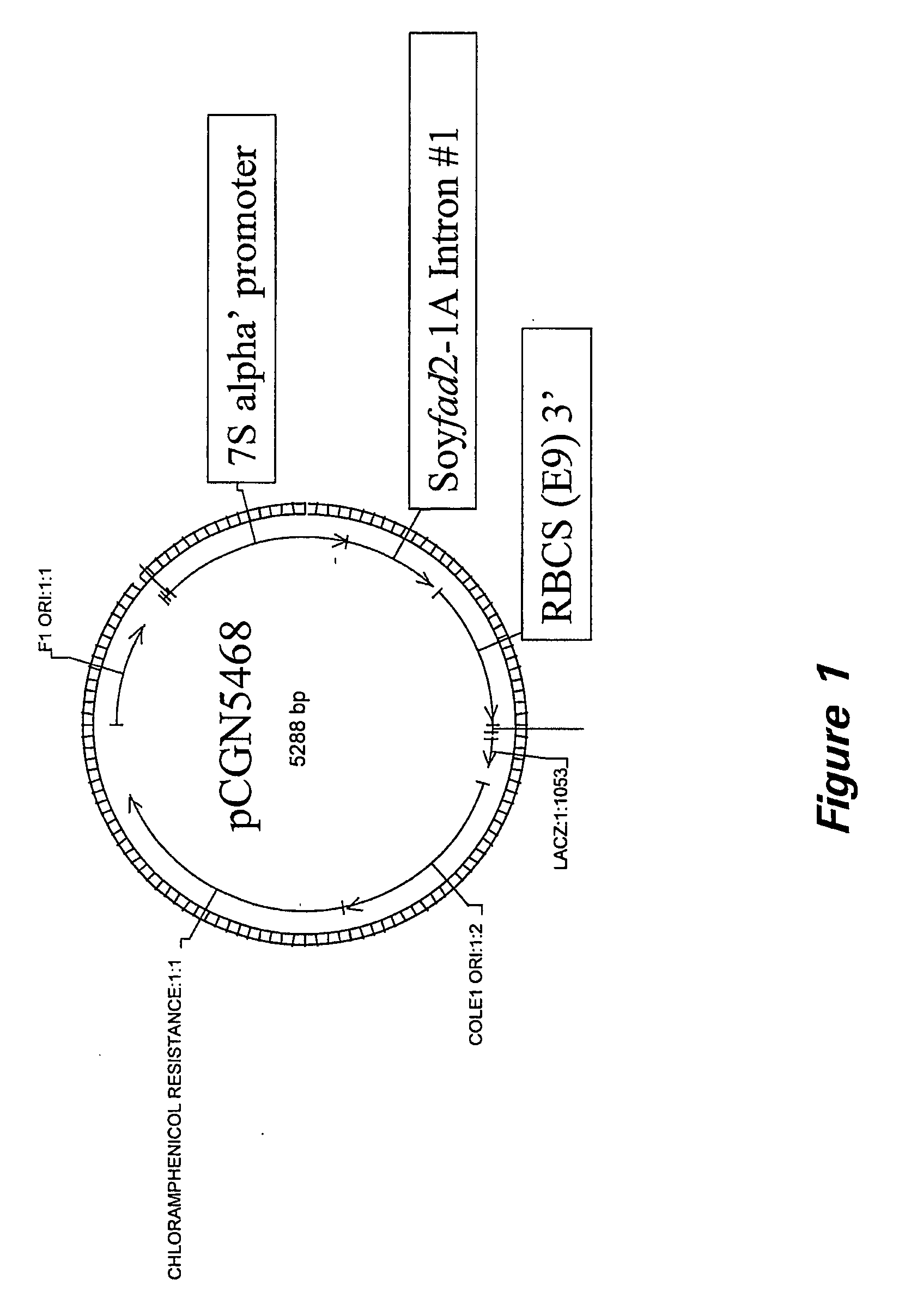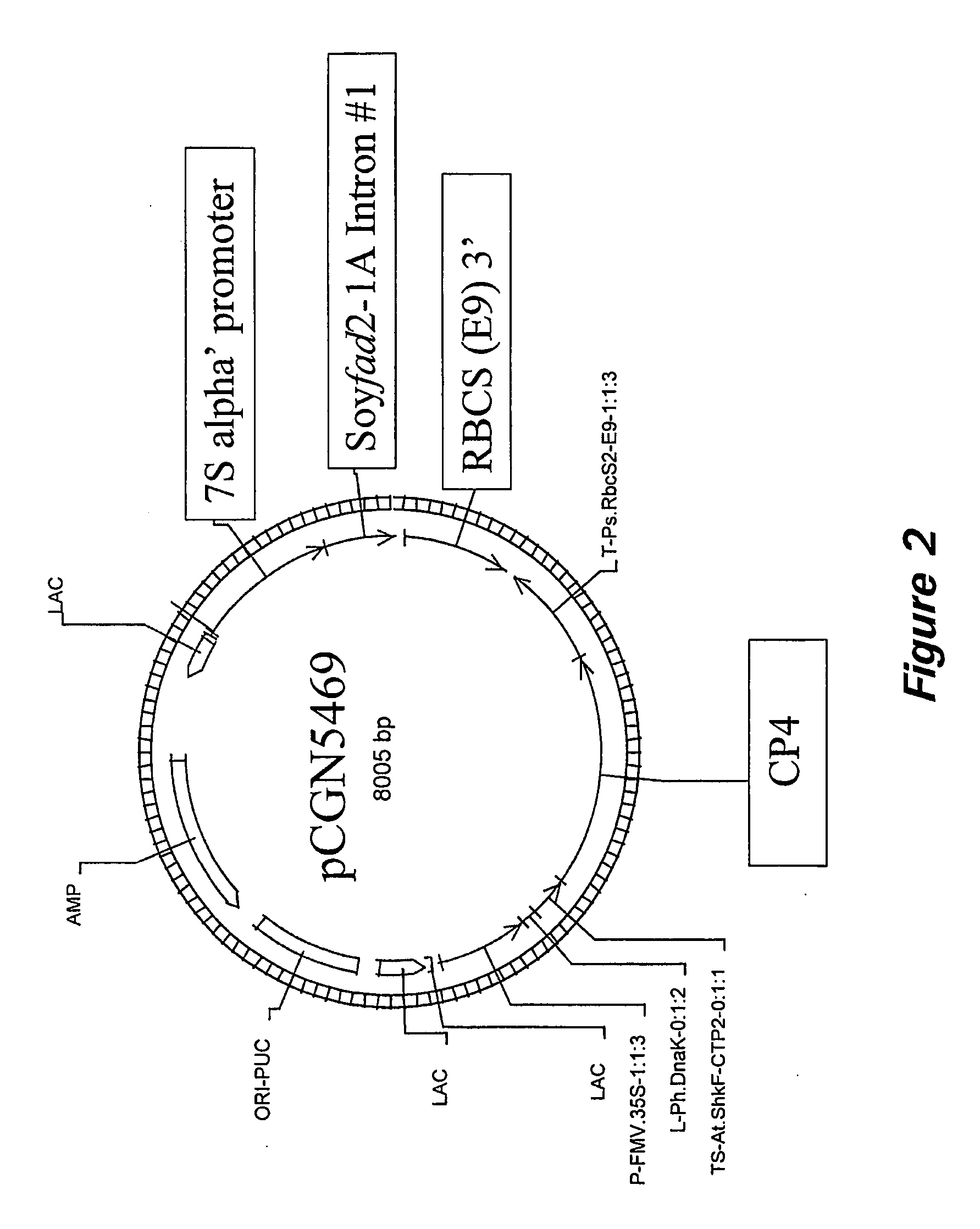Nucleic acid sequences and methods of use for the production of plants with modified polyunsaturated fatty acids
- Summary
- Abstract
- Description
- Claims
- Application Information
AI Technical Summary
Benefits of technology
Problems solved by technology
Method used
Image
Examples
example 1
Cloning of Desaturase Genomic Sequences
1A. Soybean Δ12 Desaturase (FAD2-1)
[0186] A soybean FAD2-1A sequence is identified by screening a soybean genomic library using a soybean FAD2-1 cDNA probe. Three putative soy FAD2-1 clones are identified and plaque purified. Two of the three soy FAD2-1 clones are ligated into pBluescript II KS+ (Stratagene) and sequenced. Both genomic clones (14-1 and 11-12) are the same and matched the corresponding sequence in the soy FAD2-1 cDNA exactly. A sequence of the entire FAD2-1A clone is provided in SEQ ID NO:15.
[0187] Prior to obtaining a full length clone, a portion of the FAD2-1A genomic clone is PCR amplified using PCR primers designed from the 5′ untranslated sequence (Primer 12506, 5′-ATACAA GCCACTAGGCAT-3′, SEQ ID NO:16) and within the cDNA (Primer 11698: 5′-GATTGGCCATGCAATGAGGGAAAAGG-3′, SEQ ID NO:17). The resulting PCR product is cloned into the vector pCR 2.1 (Invitrogen, Carlsbad, Calif.) and sequenced. A soy FAD2-1A partial genomic c...
example 2
Expression Constructs
2A. Construction of pCGN5468, pCGN5469, pCGN5471, pCGN5485, and pCGN5486
[0192] The FAD2-1A intron sequence (SEQ ID NO: 1) is amplified via PCR using the FAD2-1A partial genomic clone (SEQ ID NO:18) as a template and primers 12701 (5′-ACGAATTCCTCGAGGTAAA TTAAATTGTGCCTGC-3′ (SEQ ID NO:24)) and 12702 (5′-GCGAGATCTATCG ATCTGTGTCAAAGTATAAAC-3′ (SEQ ID NO:25)). The resulting amplification products are cloned into the vector pCR 2.1 (Invitrogen) and sequenced. The FAD2-1A intron is then cloned into the expression cassette, pCGN3892, in sense and antisense orientations. The vector pCGN3892 contains the soybean 7S promoter and a pea RBCS 3′. Both gene fusions are then separately ligated into pCGN9372, a vector that contains the CP4 gene regulated by the FMV promoter. The resulting expression constructs (pCGN5469 sense (FIG. 2) and pCGN5471 antisense (FIG. 3)) are used for transformation of soybean using biolistic methods described below.
[0193] The FAD2-1B intron sequ...
example 3
Plant Transformation and Analysis
[0201] Linear DNA fragments containing the expression constructs for sense and antisense suppression of the Δ12 and Δ15 desaturase genes are stably introduced into soybean (Asgrow variety A3244 or A4922A32) by the particle bombardment method of McCabe et al. (1988), Bio / Technology, 6:923-926 or via cocultivation with Agrobacterium tumefaciens, strain ABI. (Martinell, U.S. Pat. No. 6,384,310). Transformed soybean plants are identified by selection on media containing glyphosate.
[0202] Fatty acid compositions are analyzed from seed of soybean lines transformed with the intron expression constructs using gas chromatography. R1 pooled seed and R1 single seed oil compositions demonstrate that the mono- and polyunsaturated fatty acid compositions were altered in the oil of seeds from transgenic soybean lines as compared to that of the seed from non-transformed soybean. Tables I, II, and III provide summaries of results which were obtained using the descr...
PUM
| Property | Measurement | Unit |
|---|---|---|
| Fraction | aaaaa | aaaaa |
| Fraction | aaaaa | aaaaa |
| Electrical conductance | aaaaa | aaaaa |
Abstract
Description
Claims
Application Information
 Login to View More
Login to View More - R&D
- Intellectual Property
- Life Sciences
- Materials
- Tech Scout
- Unparalleled Data Quality
- Higher Quality Content
- 60% Fewer Hallucinations
Browse by: Latest US Patents, China's latest patents, Technical Efficacy Thesaurus, Application Domain, Technology Topic, Popular Technical Reports.
© 2025 PatSnap. All rights reserved.Legal|Privacy policy|Modern Slavery Act Transparency Statement|Sitemap|About US| Contact US: help@patsnap.com



